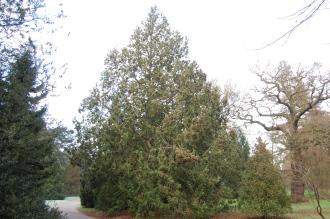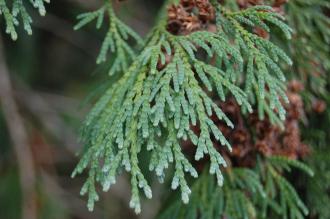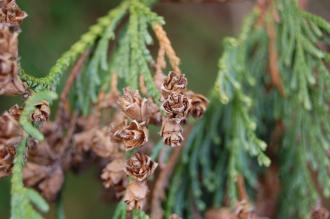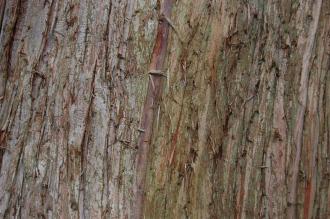
Thuja standishii (30/12/14, Kew Gardens, London)
Position: Full sun to partial shade
Flowering period: Spring
Soil: Moist, well drained
Eventual Height: 20m
Eventual Spread: 10m
Hardiness: 6a, 6b, 7a, 7b, 8a, 8b, 9a
Family: Cupressaceae

Thuja standishii Leaf (30/12/14, Kew Gardens, London)
Thuja standishii is an evergreen coniferous tree with a broadly pyramidal habit. Its mid/ dark green leaves are scale like, up to 4mm long, form flat sprays, are borne on growing lead shoots and smell of pineapple when crushed. Its trunk may achieve a diameter of up to 1m. Its red/ brown bark is fibrous with furrows and peels in longitudinal strips. Its leaves may become bronzed during the winter months. Its monoecious male flowers appear as pollen cones and up to 2mm long. Its fruit are ovoid cones, up to 12mm long, 5mm broad and initially green/ yellow become brown autumn.
Thuja standishii, commonly known as Japanese Cedar or Japanese Abortive, is native to south Japan. In its native habitat it grows as part of a sub alpine temperate forest.

Thuja standishii Seed (30/12/14, Kew Gardens, London)
The etymological root of the binomial name Thuja is derived from the Greek thuo meaning ‘to sacrifice’, in reference to the wood being burned with animal sacrifices by the ancient Greek to add a pleasing aroma to the fire. Standishii is named after John Standish (1814-1875), founder of Sunningdale Nurseries.
When available the landscape architect may find Thuja standishii useful as an evergreen parkland tree.

Thuja standishii Bark (30/12/14, Kew Gardens, London)
Ecologically, Thuja standishii is of little wildlife value in the UK.
Thuja standishii prefers moist, fertile, well-drained soils. It tolerates most pH of soil. It dislikes dry soils.
Thuja standishii requires little maintenance.

